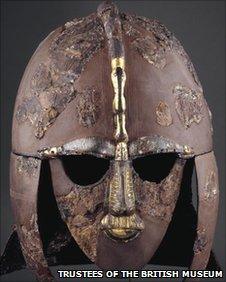Sutton Hoo dig holiday 'snaps' on display in Suffolk
- Published

Archaeologist Basil Brown within the excavated ship
Holiday "snaps" of a dig in Suffolk described as one of the greatest archaeological discoveries in the UK are being displayed for the first time.
The amateur photographs are among the few records of excavations at Sutton Hoo in 1939, the National Trust said.
School mistresses Mercie Lack and Barbara Wagstaff took pictures as archaeologists studied the construction of an Anglo-Saxon burial ship.
Their photographs are now on show at the Sutton Hoo visitor centre.
It said it believes Ms Lack and Ms Wagstaff were tipped off by an archaeologist and arrived on site shortly after a helmet, gold jewellery and other treasured possessions had been removed.
The impending outbreak of war meant the keen amateur photographers captured a phase of the excavation that received little public attention.
Royal visitors
During their time at the site, archaeologists were looking into the ship, now thought to be used to bury Anglo Saxon King Raedwald, who was laid to rest with the artefacts already found.

The Sutton Hoo helmet had been discovered before the women arrived
The National Trust said the photographs showed archaeologist Basil Brown, who made the discovery, and visitors including Princess Marie Louise, the granddaughter of Queen Victoria.
The collection also includes some of the earliest colour images from an archaeological site, which have allowed experts to gain further insight into the painstaking nature of the excavation, the National Trust added.
Until now, the majority of the prints have been kept in storage to conserve the collection and only a handful has previously been seen before, published in books.
Angus Wainwright, the National Trust's regional archaeologist, said: "These photographs are important not only for the light they shed on the excavations, but as a historic collection in its own right. The fact that there were only a few British women photographers around at that time makes the collection even more special.
"We hope that this exhibition will help us unearth more about the ladies behind the camera, as well as trace the individual who kindly donated this amazing collection to Sutton Hoo."